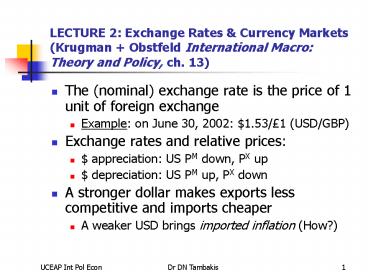LECTURE 2: Exchange Rates - PowerPoint PPT Presentation
1 / 9
Title:
LECTURE 2: Exchange Rates
Description:
The (nominal) exchange rate is the price of 1 unit of foreign exchange ... Credit risk (for bonds) = default downgrade legal. UCEAP Int Pol Econ. Dr DN Tambakis ... – PowerPoint PPT presentation
Number of Views:32
Avg rating:3.0/5.0
Title: LECTURE 2: Exchange Rates
1
LECTURE 2 Exchange Rates Currency Markets
(Krugman Obstfeld International Macro Theory
and Policy, ch. 13)
- The (nominal) exchange rate is the price of 1
unit of foreign exchange - Example on June 30, 2002 1.53/1 (USD/GBP)
- Exchange rates and relative prices
- appreciation US PM down, PX up
- depreciation US PM up, PX down
- A stronger dollar makes exports less competitive
and imports cheaper - A weaker USD brings imported inflation (How?)
2
The Foreign Exchange (FX) Market
- By far the biggest of all financial markets
- Average daily turnover gt 1.5 trillion
- The players commercial banks, corporations,
non-banks (pension funds, investment banks) and
central banks - FX trading centres Tokyo, HK/Singapore,
Frankfurt, London, NY - The market that never sleeps
- Spot versus forward exchange rates
- Derivatives markets futures and options
3
Asset Returns, Interest Rates and Risk
- Nominal rates of return nominal interest rates
i performance in money terms - definition P(t)-P(t-1)/P(t-1) x 100
- Real rates of return performance in real terms
r - Ex ante (expected inflation) versus ex post
(realized inflation) - Risk Expected ?? Realized (actual) return
- Price risk the risk that prices move over time
- Liquidity risk the risk that you cannot sell
- Political risk
- Credit risk (for bonds) defaultdowngradelegal
4
Managing (hedging) risk using financial
derivatives markets
- Impact of Hedging on the Expected Cash Flows of
the Firm
5
Exchange rate equilibrium using INTEREST RATE
PARITY
- Assume that international investors care only
about expected rates of return they are
risk-neutral - Expected rates of return, in , of investing in
and over the same time period are equal when - R R (Ee/- E/)/E/
- For example R10, R5 and (Ee/- E/)/E/
5, the expected depreciation of the dollar - Now, fixing Ee/ at, say, 1.05 /, and R at,
say, 5 we get an inverse relationship between
todays exchange rate E/ and R (Ee/-
E/)/E/ - If we then also know the fixed US dollar interest
rate R we can find the equilibrium exchange rate
when is true. This mechanism is known as
interest rate parity.
6
Example The equilibrium / exchange rate
E/
2
1
Expected return on euro deposits
3
R
Rates of return in dollars
7
How does equilibrium change over time?
- Remember the expected future Ee/ exchange rate
level is fixed for now (so expected depreciation
also) - Changing stance of US monetary policy
- R rises vertical shifts right -gt appreciates
now ( depreciates) - R falls vertical shifts left -gt depreciates
now ( appreciates) - Changing stance of the euro-zones monetary
policy - R rises sloping line shifts out -gt
appreciates now ( depreciates) - R falls sloping line shifts in -gt depreciates
now ( appreciates) - Now suppose that currency market sentiment
changes Ee/ can vary - Ee/ rises sloping line shifts out -gt
depreciates now - Ee/ falls sloping line shifts in -gt
appreciates now
8
Interest Rate Differential between Dollar- and
Peso-Denominated Deposits in Argentina (basis
points 1/100 of a percent)
- Interest Differential on Dollar- and
Peso-Denominated Deposits in Argentina (basis
points 1/100 of a percent)
9
Summary (and caveat)
- Interest rates and exchange rates can be closely
linked in the short term (lt1 year) - Exchange rates are very difficult to forecast
- Random walks may perform better than
macroeconomic models - Risk was not included. In reality investors are
risk-averse prefer less risk w/same Ereturn - We need risk premia (p), especially for emerging
markets, to capture political risk etc - R - R (Ee/- E/)/E/ p
- Be careful about interpreting the sign of p !































